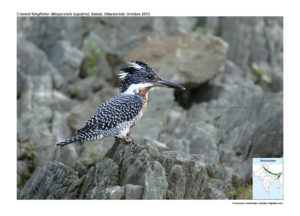Crested Kingfisher

Crested Kingfisher Megaceryle lugubris
Etymology:
- Megaceryle : Greek word megas- great; Ceryle – kerulos mythical bird associated with Halcyon ( Kingfisher)
- Lugubris: Latin word for mournful derived from mournful lugere –to mourn
Distribution in India: Resident in Himalayas and North East India.
Description: Size of 41-43 cm. It is a distinctive large kingfisher with long crest feathers. The adult male nominate race has white loral spot, long feathers on forehead and crown blackish-grey, spotted with white, when erect two patches of shorter white feathers; white-speckled black malar stripe, white collar; upperparts barred black and white, tail black with 6–8 white bars; white underparts, black-speckled breast band with rufous-orange feathers admixed, flanks barred with grey. The bill is black, basal half pale blue, tip yellowish; iris dark brown; legs and feet dark olive-grey. The adult female is like male, but no rufous on breast, has bright pink-cinnamon underwing-coverts.
Habitat:It is found in smaller, fast-flowing streams and rivers with rock or gravel base, in forested mountains and foothills; sometimes found at large rivers and river mouths; avoids rivers with bare open banks, present along turbulent rapids. Found from Seashore up to 2800 m.
Food Habits:It eats mainly Fish and Crayfish. It perches on an overhanging branch, partly submerged log or rock, occasionally bobbing head, raising crest and flicking tail, then dives obliquely into water for a fish. Favoured stretches of river are fished repeatedly.
Breeding Habits: They breed in Mar-July in Nepal, China and Japan. Both sexes dig tunnel 2–3 m long and 10–15 cm wide, ending in a chamber 30–50 cm wide. They lay a clutch 4-7 eggs. The female parent incubates. The fledging period is 40 days. Both sexes feed the young.